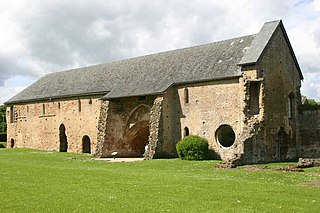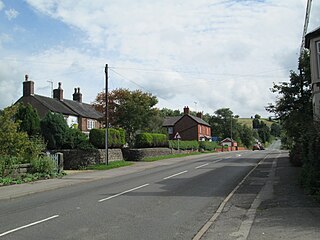
Abbots Bromley is a village and civil parish within the English county of Staffordshire, England. A notably affluent part of the county, Abbots Bromley was rated the best place to live in the Midlands by the Sunday Times in 2013 and again in 2016. The village is a regular entrant and often winner of the Staffordshire Best Kept Village Competition which takes place across the county each year. Originally organised by the Community Council of Staffordshire there is a best-kept village award for a large and small village in each of the county's Districts and Boroughs. Whilst down the years the East Staffordshire district prize has been awarded to Abbots Bromley on a number of occasions the overall county title continues to elude. In August 2017 the village won the double honour of winning both the best kept village and community council trophy award, a double not achieved for many years. This double was repeated again in 2018. In 2019 the competition was taken on by The Community Foundation for Staffordshire and Abbots Bromley won for the third consecutive year. Through the competition Abbots Bromley maintains a healthy rivalry with nearby Yoxall, also a regular winner in the East Staffordshire section.

Shackleford is a village and civil parish in the Borough of Guildford, Surrey, England centred to the west of the A3 between Guildford and Petersfield 32 miles (51 km) southwest of London and 5.2 miles (8.4 km) southwest of Guildford. Shackleford includes the localities of Eashing, Hurtmore, Norney and Gatwick.

Alfold is a village and civil parish in Surrey, England on the West Sussex border. Alfold is a dispersed or polyfocal village in the Green Belt, which is buffered from all other settlements. The Greensand Way runs north of the village along the Greensand Ridge and two named localities exist to the north and south of the historic village centre which features pubs, a set of stocks and a whipping post.

Alvediston is a small village and civil parish in Wiltshire, England, about 7 miles (11 km) east of Shaftesbury and 11 miles (18 km) southwest of Salisbury. The area is the source of the River Ebble and is within the Cranborne Chase and West Wiltshire Downs Area of Outstanding Natural Beauty.

Quarr Abbey is a monastery between the villages of Binstead and Fishbourne on the Isle of Wight in southern England. The name is pronounced as "Kwor". It belongs to the Catholic Order of St Benedict.

Mells is a village and civil parish in Somerset, England, near the town of Frome.

West Camel is a village and civil parish in south Somerset, England, about 7 miles (11.3 km) north of the town of Yeovil. It lies either side of the River Cam, just south of the A303, and has a population of 459. The parish includes the hamlet of Urgashay. Neighbouring villages include Queen Camel, and Bridgehampton.

Cleeve Abbey is a medieval monastery located near the village of Washford, in Somerset, England. It is a Grade I listed building and has been scheduled as an ancient monument.

Combermere Abbey is a former monastery, later a country house, near Burleydam, between Nantwich and Whitchurch in Cheshire, England, near the border with Shropshire. Initially Savigniac and later Cistercian, the abbey was founded in the 1130s by Hugh Malbank, Baron of Nantwich, and was also associated with Ranulf de Gernons, Earl of Chester. The abbey initially flourished, but by 1275 was sufficiently deeply in debt to be removed from the abbot's management. From that date until its dissolution in 1538, it was frequently in royal custody, and acquired a reputation for poor discipline and violent disputes with both lay people and other abbeys. It was the third largest monastic establishment in Cheshire, based on net income in 1535.

Revesby Abbey was a Cistercian monastery near the village of Revesby in Lincolnshire, England. The abbey was founded in 1143 by William de Roumare, Earl of Lincoln, and the first monks came from Rievaulx Abbey.

Ogbourne St George is a village and civil parish on the River Og about 3 miles (4.8 km) north of Marlborough, Wiltshire, England.

Dieulacres Abbey was a Cistercian monastery established by Ranulf, Earl of Chester at Poulton in Cheshire. It moved to the present site at Abbey Green near Leek, Staffordshire in 1214, possibly in part as a result from raids at the former site by the Welsh.

Clifton upon Teme is a village and civil parish in the Malvern Hills District in the county of Worcestershire, England.

Edwardstone is a village and civil parish in the Babergh district, in the county of Suffolk, England. The parish contains the hamlets of Mill Green, Priory Green, Round Maple and Sherbourne Street, and Edwardstone Woods, a Site of Special Scientific Interest. The parish touches Boxford, Great Waldingfield, Groton, Little Waldingfield, Milden and Newton.

Haughley is a village and civil parish in the English county of Suffolk, about two miles from Stowmarket in the Mid Suffolk District. The village is located 2 miles (3.2 km) miles northwest of the town of Stowmarket, overlooking the Gipping valley, next to the A14 corridor. The population recorded in 2011 was 1,638. Mentioned in the Domesday Book, it was the site of a castle, a church on the pilgrim's route to Bury St Edmunds Abbey, and a market. Adjacent farms on the north side of the village were also home to one of the first studies of organic farming and the first headquarters of the Soil Association.

Hangleton Manor Inn, the adjoining Old Manor House and associated buildings form a bar and restaurant complex in Hangleton, an ancient village which is part of the English city of Brighton and Hove. The manor house is the oldest secular building in the Hove part of the city; some 15th-century features remain, and there has been little change since the High Sheriff of Sussex rebuilt it in the mid-16th century. Local folklore asserts that a 17th-century dovecote in the grounds has been haunted since a monk placed a curse on it. The buildings that comprise the inn were acquired by Hangleton Manor Ltd in 1968, and converted to an inn under the Whitbread banner. The brewery company Hall & Woodhouse have owned and operated it since 2005. English Heritage has listed the complex at Grade II* for its architectural and historical importance, and the dovecote is listed separately at Grade II.

Rushton is a civil parish in Staffordshire, England. The village within the civil parish, usually known as Rushton Spencer, is about 4 miles (6.4 km) north of Leek and 7 miles (11 km) south of Macclesfield, on the A523 road which runs between these towns.

Leekfrith is a civil parish in the Staffordshire Moorlands, in Staffordshire, England, north of the town of Leek. The population of the civil parish at the 2011 census was 363.
Tittesworth is a civil parish in the Staffordshire Moorlands, in Staffordshire, England. It extends from the edge of the town of Leek in the south-west to Blackshaw Moor in the north-east. In the east is the village of Thorncliffe. To the west is the civil parish of Leekfrith, where the boundary is the River Churnet.To the east is the civil parish of Onecote. Tittesworth Brook runs westwards through the area from Thorncliffe, and flows into the Churnet.

Sheen is a village and civil parish in north-east Staffordshire, England.




















